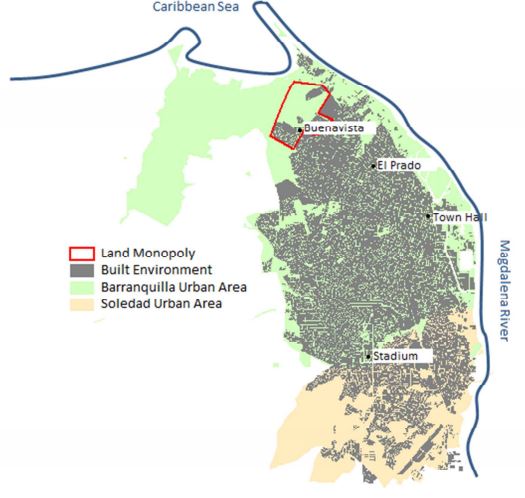An empirical approach to urban land monopoly: A case study of Barranquilla, Colombia
Blog by Nestor Garza and Colin Lizieri
- Created
- 18 Sep 2018, 4:18 p.m.
- Author
- Nestor Garza and Colin Lizieri
- DOI
- 10.1177/0042098018781306
Abstract: http://journals.sagepub.com/doi/full/10.1177/0042098018781306
Concentration of land ownership seems pervasive, particularly in developing countries. Land concentration has been historically related to concentration of political power, with regressive social consequences when used for manipulating public policy, for example taxation. In urban settings, land-related political manipulation tends to coincide with higher prices, spatial segregation and lower environmental quality, magnifying gains to landowners from development and infrastructure improvement.
However, the specific mechanisms through which land concentration impacts urban development patterns have not been fully investigated, even though this was a key theme for the early political economists. Recent mainstream urban economics has broadly remained silent about land concentration both as a theoretical and as an empirical research topic.
To address this neglect, we have designed a test of the mechanisms by which land concentration in urban areas might produce land prices, ‘above and beyond’ those determined by location, regulation and externalities – the conventional drivers of price in urban economic models. Our test models spatial and temporal land price changes and their determinants, allowing to separate the “pure” effect of land concentration (if any) within city zones.
Land is a particular good. Its fixed location and supply inelasticity causes each and every plot in the city to be a ‘site monopolist’, regardless of its size. This particularity determines the theoretical impossibility of the existence of land monopolies with an interesting policy implication: land owners cannot behave strategically and cannot sustain land strikes as a long-term strategy to generate abnormal returns. If this theoretical precept holds then, consequently, land taxation and land value capture become feasible policies since landowners cannot pass forward these measures to final users as higher land prices.
The setting for our case study is Barranquilla, Colombia, a city where a single corporation owns more than 90% of the expansion land in its northern fringe. That zone is characterized by high property values, and is destined for elite housing and commercial uses, in a context of strong urban regulation. We show in our article how these characteristics increase the likelihood of having a land monopoly situation.
Our land monopoly test detects if the spatial-temporal association between income and land price (its elasticity) differs by zones. It also detects the degree of those differences, while controlling for spatial and non-spatial theoretical determinants of land prices and their growth. If the land monopoly zone has a higher elasticity, with a spatial independent structure and predicted higher prices when compared to other selected zones, then we have evidence of land monopoly pricing.
Barranquilla (and Colombia more generally) have notorious land issues, but despite the extreme concentration of ownership in our case study, we do not find evidence of land monopoly pricing. This has valuable policy implications, implying that value capture policies can be effective in developing urban contexts, although political power dimensions remain.
This type of research is scarce in the field of urban studies, and virtually absent from urban economics - despite the importance of land markets as determinants of urban development patterns in the contemporary world. We consider that a stronger, and specific (dynamic and spatial) knowledge of land markets functioning is needed to fully grasp the implications of global real estate and neoliberalism on our urban world.
Map: Barranquilla and Soledad, land monopoly zone and sub-centres
Source: Own elaboration using city cartography block level
Read the paper on Urban Studies - OnlineFirst here



Comments
You need to be logged in to make a comment. Please Login or Register
There are no comments on this resource.